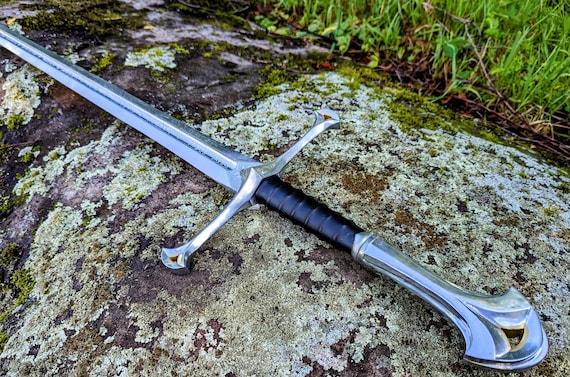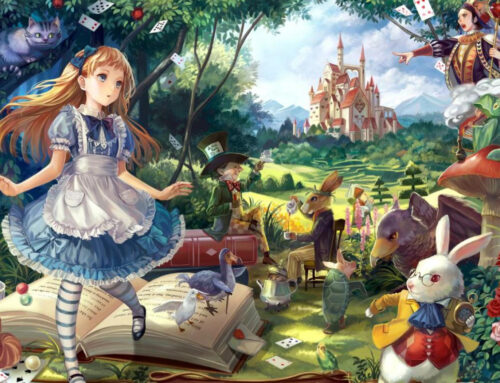Fantasy literature and media have introduced us to countless mythical realms where valiant heroes and formidable villains wield weapons of unimaginable power. Among these, legendary swords often stand out as symbols of heroism, destiny and sheer magical might.
No epic fantasy story is complete without a legendary sword, right? While a tale might still be intriguing without one, let’s be real: a great sword has the power to ignite your inner warrior and inspire you to take up arms. Here, we unveil some of the most iconic and revered fantasy swords that have captured the imaginations of audiences worldwide.
Not in the mood to read? Watch the video here.
(1) Excalibur
No list of legendary swords is complete without mentioning Excalibur, the mythical blade of King Arthur.
Excalibur, the legendary sword of King Arthur, is one of the most iconic symbols in Arthurian legend and Western mythology. Its origins are steeped in mystery and magic, with various accounts describing how Arthur came into possession of the sword. In one version of the tale, Excalibur is bestowed upon Arthur by the Lady of the Lake, a mystical figure who dwells in the enchanted waters. In another well-known narrative, Arthur pulls the sword from a stone, proving his divine right to rule. This act of pulling the sword from the stone is often depicted as a test of true kingship, emphasizing the idea that only the rightful sovereign can wield Excalibur’s unparalleled power.
The sword itself is often described as having extraordinary qualities. Excalibur is said to possess a magical scabbard that protects its bearer from harm, rendering them nearly invincible in battle. This dual aspect of the sword and its scabbard highlights the balance of power and protection, both essential for a just and effective ruler. Excalibur’s blade is often depicted as gleaming brightly, sometimes described as being able to blind its enemies or cut through any material. These attributes elevate Excalibur from a mere weapon to a symbol of divine authority and justice, reinforcing the idea that King Arthur’s rule was sanctioned by higher powers.
Excalibur’s significance extends beyond its physical properties, playing a crucial role in the broader themes of Arthurian legend. It symbolizes the ideals of chivalry, honor, and rightful leadership that Arthur and his Knights of the Round Table strive to uphold. The sword’s association with mystical elements and its connection to Arthur’s destiny underscore the interplay between the mortal and the divine in these stories. Excalibur’s eventual return to the Lady of the Lake upon Arthur’s death marks the end of an era, signifying the transient nature of even the greatest of kingdoms. The enduring legacy of Excalibur in literature, art, and popular culture continues to inspire and captivate, embodying the timeless allure of heroism and the quest for a just and noble reign.
(2) Andúril – Lord of the Rings

J.R.R. Tolkien’s Middle-earth saga brings us Andúril, the reforged sword of King Aragorn. Andúril, also known as the Flame of the West, is a fictional sword from J.R.R. Tolkien’s epic fantasy novel “The Lord of the Rings”. The sword was forged from the shards of the sword Narsil, which had been broken during the Last Alliance of Elves and Men. Narsil was wielded by Isildur, who used it to cut the One Ring from the hand of Sauron, thus ending the Second Age of Middle-earth.
After the defeat of Sauron, Isildur was ambushed and killed by Orcs, and Narsil was broken. The shards of the sword were kept as a symbol of hope for the people of Gondor and Arnor. Centuries later, the sword was reforged by the dwarf-smith Telchar and given a new name, Andúril, meaning “Flame of the West”.
Andúril played a crucial role in the War of the Ring, as it was wielded by Aragorn, the heir of Isildur and rightful King of Gondor and Arnor. With Andúril in hand, Aragorn led the Fellowship of the Ring in their quest to destroy the One Ring and defeat Sauron.
Andúril was described as a magnificent sword, with a blade that shone with a white light and a hilt that was adorned with the emblem of the tree of Gondor. It was said to be a symbol of the power and authority of the rightful king, and it inspired hope and courage in those who fought alongside its wielder.
Overall, Andúril was a powerful and iconic weapon in the world of Middle-earth, and its role in the story of “The Lord of the Rings” helped to make it one of the most beloved fantasy novels of all time.
(3) Stormbringer (Elric of Melniboné)
Stormbringer, the infamous sword from Michael Moorcock’s “Elric of Melniboné” series, stands as one of the most complex and sinister weapons in fantasy literature. Unlike traditional heroic swords, Stormbringer is a sentient, vampiric blade with a thirst for souls. It grants its wielder, Elric of Melniboné, immense power and strength, but at a terrible cost. The sword is black as night, adorned with runes that glow ominously when it drinks the souls of its victims. This dark symbiosis between Elric and Stormbringer highlights the central themes of Moorcock’s work: the fine line between power and corruption, and the tragic consequences of dependency on dark forces.
Stormbringer’s relationship with Elric is both empowering and parasitic. On one hand, the sword provides Elric with the physical strength and vitality he lacks due to his albinism and frail constitution. This enables him to lead his people and confront formidable enemies. On the other hand, the sword exerts a malevolent influence over Elric, often pushing him to commit acts of violence and destruction against his will. Stormbringer’s hunger for souls means that even those close to Elric, including his friends and loved ones, are not safe from its insidious appetite. This dichotomy creates a poignant and tragic narrative, as Elric struggles to retain his humanity while wielding a weapon that constantly seeks to erode it.
The presence of Stormbringer in the “Elric of Melniboné” series also serves as a broader metaphor for the themes of chaos and order that Moorcock explores throughout his work. The sword embodies the chaotic forces that Elric must navigate in a world where traditional notions of good and evil are often blurred. Its insatiable nature and destructive power are a stark reminder of the dangers inherent in seeking power without regard for the consequences. Stormbringer’s ultimate fate is intertwined with Elric’s destiny, culminating in a story that is as much about the internal battle between light and darkness as it is about external conflicts. Through Stormbringer, Moorcock crafts a tale that challenges readers to consider the true cost of power and the enduring struggle for balance in a chaotic world.
(4) Ice – A Game of Thrones

The sword Ice is a significant weapon in the book series “A Song of Ice and Fire” by George R.R. Martin and its television adaptation “Game of Thrones.” It is a Valyrian steel greatsword that belongs to House Stark, the ruling family of the North.
The sword has been in the possession of House Stark for generations and has been passed down from father to son. It is a symbol of the family’s power and honor and is often used in ceremonies and battles.
In the story, Ice is wielded by Lord Eddard Stark, the head of House Stark and the Warden of the North. He uses the sword to execute deserters and criminals, as well as in battles during the War of the Five Kings.
However, in a shocking turn of events, Ice is eventually taken from House Stark and melted down into two separate swords by House Lannister after Eddard is betrayed and executed. This act serves as a powerful symbol of the Lannister’s dominance over the Stark family and their hold on power in the realm.
The two swords made from Ice, Widow’s Wail and Oathkeeper, play a significant role in later parts of the story, as they are wielded by important characters and used in key battles.
Overall, the sword Ice is a crucial part of the story’s lore and serves as a symbol of power, honor, and the shifting balance of power between the various houses in the realm.
(5) Buster Sword – Final Fantasy 7
Square Enix’s “Final Fantasy VII” introduces the Buster Sword, wielded by the game’s protagonist, Cloud Strife. Known for its massive size and distinctive design, the Buster Sword is a symbol of Cloud’s strength and his troubled past. It has become one of the most recognizable weapons in video game history, representing the enduring appeal of the “Final Fantasy” franchise and its epic tales of heroism and adventure.
The Buster Sword is an iconic weapon that originated from the popular Japanese role-playing video game, Final Fantasy 7. It is wielded by the game’s main protagonist, Cloud Strife, and has become a symbol of his character.
The Buster Sword is a massive weapon, measuring approximately five feet long (1,5m) and weighing over 80 pounds (36kg). It features a distinctive design, with a broad blade and a pair of wing-like guards. The sword’s size and weight make it a formidable weapon, capable of inflicting massive damage on enemies.
In Final Fantasy 7, the Buster Sword is an important part of Cloud’s character development. He originally used the sword as a member of SOLDIER, an elite military group, but eventually gave it up and became a mercenary. When he picks up the Buster Sword again later in the game, it represents his decision to take up arms and fight for a cause he believes in.
The Buster Sword has also become a popular symbol in the wider gaming community, and has appeared in a number of other games and media. Its distinctive design and association with Final Fantasy 7 have made it an enduring icon of video game culture.
(6) The Sword of Gryffindor
(7) The Master Sword: The Blade of Evil’s Bane
The Master Sword, also known as the Blade of Evil’s Bane, is one of the most iconic and revered weapons in video game history, primarily featured in Nintendo’s “The Legend of Zelda” series. This legendary sword is the key to defeating the forces of darkness that threaten the land of Hyrule. It is traditionally wielded by the series’ hero, Link, who is often depicted as the chosen one destined to combat the malevolent Ganon. The sword’s design is instantly recognizable, with its gleaming blade, winged crossguard, and blue hilt, symbolizing purity and the divine right to vanquish evil.
The Master Sword’s lore is deeply intertwined with the mythology of Hyrule. According to legend, the sword was forged by the goddess Hylia to aid the hero in his battle against the forces of evil. It is typically found in the Pedestal of Time or some other sacred resting place, awaiting the hero who can prove their worthiness by demonstrating courage, wisdom, and power. This quest to obtain the Master Sword often serves as a pivotal moment in Link’s journey, signifying his transformation from an ordinary individual into the hero of Hyrule. The trials he faces to claim the sword underscore the themes of growth, self-discovery, and the hero’s journey that are central to the series.
The Master Sword’s powers extend beyond its physical attributes, playing a crucial role in the overarching narrative of “The Legend of Zelda.” It is often depicted as the only weapon capable of repelling Ganon and sealing away his dark magic. The sword’s ability to emit a powerful, radiant energy when wielded by a true hero underscores its role as a beacon of hope and a symbol of the eternal struggle between good and evil. Over the course of the series, the Master Sword has appeared in various incarnations, each with its own unique challenges and stories, but its core essence as a weapon of light and justice remains constant. The Master Sword’s enduring legacy in the gaming world continues to inspire players and stands as a testament to the timeless appeal of the heroic quest.
(8) Yamato: The Dimension-Cutting Katana
(9) Sting – The Hobbit
Sting is a magical sword that plays a significant role in J.R.R. Tolkien’s novel “The Hobbit.” It was originally a sword of the ancient Elvish kingdom of Gondolin, and was later found by Bilbo Baggins in a troll hoard along with other valuable treasures.
In the story, Sting is described as a short sword, just the right size for a hobbit, with a blade that glows blue whenever Orcs, Goblins or other enemies of the free peoples of Middle-earth are near. This makes it an incredibly useful tool for Bilbo and the company of dwarves on their quest to reclaim the Lonely Mountain from the dragon Smaug.
One of the reasons why Sting is such an important weapon is that it is made of Elvish steel, which is known for its exceptional sharpness and strength. This makes it effective against even the toughest foes, such as the giant spiders that the party encounters in Mirkwood.
But Sting’s greatest power is its ability to detect the presence of evil. When Bilbo first uses it against a group of goblins in the Misty Mountains, he is surprised to see the sword begin to glow, warning him of the danger. From that point on, Sting becomes an invaluable asset to the quest, allowing Bilbo and his companions to anticipate and avoid many dangerous situations.
Sting’s significance goes beyond its practical uses, however. It also serves as a symbol of Bilbo’s transformation from a timid and sheltered hobbit into a brave adventurer who is willing to risk his life for the greater good. By the end of the story, Bilbo has come to rely on Sting as much as he has on his own courage and resourcefulness.
Overall, Sting is a memorable and beloved part of Tolkien’s rich and complex world, and its role in “The Hobbit” serves as a reminder of the power of both magic and the human spirit.
(10) The Atlantean Sword – Conan
The Atlantean Sword is an iconic weapon from the world of Conan the Barbarian. It is a massive, two-handed sword that was originally wielded by King Atlantis, an ancient ruler of the mythical city of Atlantis. According to the lore of the Conan universe, the sword was forged from a meteorite, and possesses incredible strength and durability.
Conan, the eponymous hero of the series, comes into possession of the Atlantean Sword early in his adventures. He discovers the sword in the ruins of an ancient temple, and is immediately struck by its size and weight. Despite the fact that the sword is almost too large for him to wield, Conan proves to be a master of its use, and the Atlantean Sword becomes his signature weapon.
The Atlantean Sword is a symbol of Conan’s power and prowess as a warrior. Its size and weight make it a fearsome weapon on the battlefield, capable of cleaving through armor and bone with ease. But it is also a symbol of Conan’s connection to the ancient world, and to the powerful forces that shaped it. The fact that the sword was forged from a meteorite suggests that it has a mystical origin, and Conan’s ability to wield it effectively is a testament to his strength, both physical and spiritual.
In popular culture, the Atlantean Sword has become one of the most iconic weapons in fantasy fiction. Its distinctive design and association with Conan have made it a favorite among fans of the genre, and it has appeared in countless movies, TV shows, and video games over the years. But for fans of the original Conan stories, the sword remains a powerful symbol of the world that Robert E. Howard created, and of the hero who conquered it.















